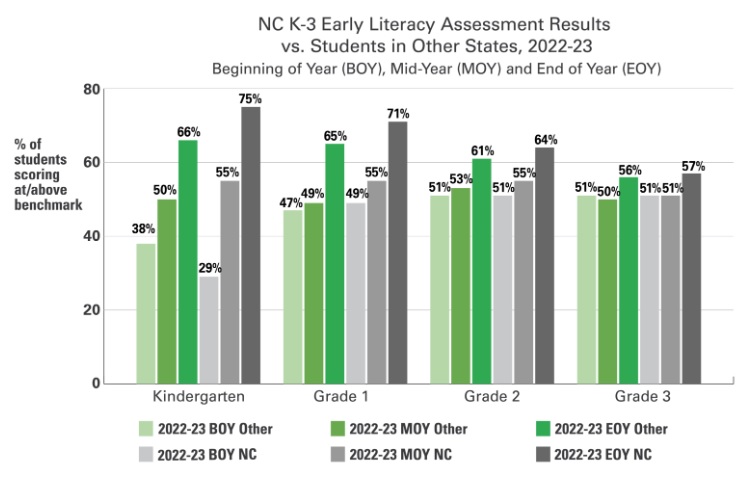
Special to Iredell Free News
RALEIGH — Students in early elementary grades in North Carolina public schools made strong gains in their literacy skills during the 2022-2023 school year, according to assessment results presented to the State Board of Education on Thursday by State Superintendent of Public Instruction Catherine Truitt.
The results of the final assessment of the year showed marked improvements from the start of the year, with the percentage of students who measured “on track” more than doubling in kindergarten, increasing by 22 percentage points in first grade and by 13 points in second grade.
The gains by North Carolina students were achieved by the end of the second full year of a far-reaching statewide initiative to support elementary school teachers with extensive training in instruction based on the “science of reading,” a phonics-based approach with strong evidence of effectiveness.
North Carolina’s gains in all three grades outpaced those of other states and districts that use the same early literacy screener, known as the DIBELS 8 (Dynamic Indicators of Basic Early Literacy Skills), an updated version of the previous DIBELS assessment from mCLASS. The 6-point gain by North Carolina’s third graders was about on par with the comparison group, with a 5-point increase from the beginning of the school year.
Additionally, North Carolina’s statewide results show that fewer students at the end of the year were well below assessment benchmarks and in need of intensive intervention. Kindergartners, in particular, saw a steep decline in the percentage of students considered at risk of requiring such intervention, falling 38 percentage points, from 53 percent at the start of the year to 15 percent by year’s end.
Truitt attributes the latest assessment outcomes to the state’s full-court press effort to improve reading skills among all students through the two-year professional development program, Language Essentials for Teachers of Reading and Spelling, or LETRS.
“Improving reading outcomes for students in our state has been a priority since I began in January 2021,” Truitt said. “I’m thrilled because this year’s results show the state’s firm commitment to literacy instruction grounded in the science of reading is beginning to pay off.
“North Carolina’s teachers and administrators have done an extraordinary job implementing this professional development in the classroom, and it’s clearly changing the trajectory of reading achievement for North Carolina’s students. There is more work to do, but our state is well on its way to laying the foundational literacy skills that are critical for students to become strong readers.”

Year-end results disaggregated by race and ethnicity also reflected similar patterns of improvement in percentages of students “on track” and decreases in the percentages of students needing intensive intervention. All the subgroups reported for North Carolina – white, Asian, Black, Hispanic, and Native American/Alaskan native – outpaced their comparison subgroups elsewhere who were administered the same DIBELS 8 screener, a component of the mCLASS assessment from Amplify, the education company that provides the assessment under contract with the Department of Public Instruction.
The early literacy screener, DIBELS 8, is based on the science of reading and measures students’ risk level on component skills involved in reading such as phonemic awareness and phonics. The tool was used with all kindergarten through third grade students in North Carolina for the first time in the 2021-2022 school year. The measures increase in complexity from grade level to grade level and increase in complexity throughout the year within a grade level.
Amy Rhyne, director of DPI’s Office of Early Learning, said students in kindergarten and first grade have benefitted the most so far from the state’s shift to instruction based on the “science of reading,” and their gains in 2022-2023 bear that out.
“This is why you see kindergarten and first grade coming in so strong,” Rhyne said. “Teachers have had the training and students are already being impacted.”
Students in second and third grades, however, didn’t have the same exposure when they were in the earliest grades, she said. In addition, many of last year’s third-graders were handicapped by remote instruction for a year or more when they were in kindergarten and first grades.
“Our third-grade students didn’t have in-person learning for nearly one and a half years,” Rhyne said. “Teaching sounds and attention to mouth formation to perform those sounds as a basic skill is nearly impossible in a virtual setting.”
To date, Rhyne said, 29 North Carolina school districts have completed the LETRS professional learning, including nearly 10,000 (K-5) educators, 870 (pre-K) educators, and more than 500 administrators. A second cohort of educators is scheduled to finish this winter, with a third and final cohort set to complete it by summer of 2024. Full statewide implementation and application of the teaching strategies will require additional time.
North Carolina’s assessment results were compared with those of 1.6 million K-3 students elsewhere in the nation whose literacy skills are measured with the same assessment, according to Amplify.
The assessment results are not comparable to the state’s end-of-grade reading tests, which are administered beginning in the third grade. Those exams measure whether a student has mastered grade-level standards, from a basic level to more rigorous comprehension, while the DIBELS 8 assessment measures the foundational skills that students need to become successful readers.
Teachers administer the DIBELS 8 assessment with students individually at the beginning, middle and end of the school year, and are encouraged to use it between established benchmarks to monitor student progress. In addition to student progress monitoring data, the various component skills that are measured also help guide teachers in their literacy instruction and interventions.



